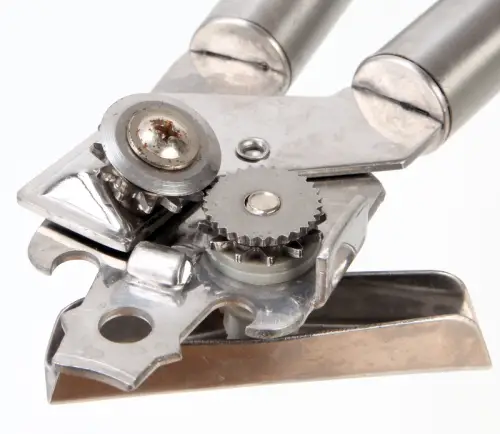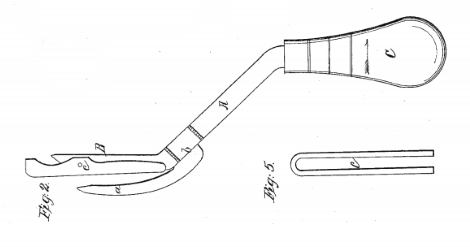If not for Connecticut’s Ezra Warner, cooks might still be fumbling for a rock and a bayonet to get their dinners.
While the original inventors of canning processes thought a lot about how to keep food safe and fresh in its can, they didn’t think much about how to actually get it out.
A Frenchman, Philippe de Girard, invented the process of canning foods. And an Englishman, Peter Durand, patented it in 1810. But it would take more than 40 years before someone figured out an easy way to get food out of the cans.
Canning was a huge innovation, especially for supplying and feeding soldiers and sailors. But early cans were not what we’re used to today. Assembled with lead solder, the cans could be heavier than the food they held.
Ezra Warner
To open tin cans, soldiers used bayonets. Instructions for civilians read, “Cut round the top near the outer edge with a chisel and hammer.”

Tin cans got lighter, which allowed Ezra Warner’s invention to work
The difficulty of opening cans posed the problems of the opener risking injury and the contents splashing about and making a mess. This went on for 40 years.
Enter Ezra Warner of Waterbury, Conn. Warner was already a successful businessman in the 1850s. He held stock in the Waterbury Hook and Eye Company. He held a patent on a “Mode of Fastening Hooks and Eyes upon Cards” he had invented. His invention let manufacturers easily package and ship hooks and eyes.
In 1858 he turned his innovative mind to the process of opening cans. Warner developed a new can opener – the first patented in America – that had a lever and a cutter. That allowed “the operator to cut as fast as he can move his hand,” he explained in the patent for the device.

Maybe Warhol should have done the opener, too
Child’s Play?
“The advantages of my improvement over all other instruments for this purpose consist in the smoothness and rapidity of the cut, as well as the ease with which it is worked,” Warner wrote.
And then he probably oversold the device, claiming, “a child may use it without difficulty, or risk.” Children whose parents let them use Warner’s can opener might find themselves in foster care. Grocery clerks used Warner’s can opener before the can left the store.
Warner further explained the curved cutter of his device could be removed. “So that if one should be injured it may be replaced by another, thus saving all the other portions of the instrument, and consequently much expense, and in that the piercer will perforate the tin without causing the liquid to fly out, as it does in all those which make the perforation by percussion of any kind.”
Storekeepers found Warner’s opener useful to pop open cans and sell the contents to customers. The biggest success for Warner came when the Union Army adopted his can opener during the Civil War.

Bull can opener
In the 1860s, cans of “bully beef” were sold with can openers. Bully beef, probably as alarming as it sounds, consisted of shredded beef in a bouillon or gelatin. The cast-iron openers had the shape of a bull’s head with the handle forming his tail.

A modern can opener
William Lyman of Meriden, Conn., advanced can opener technology further in 1870 with a patent for the first rotary opener. which was widely adopted for home use. The hand crank can opener still in use today replaced Lyman’s rotary opener.
This story last updated in 2022.
Images: Can opener By MAbW – Own work, CC BY-SA 4.0, https://commons.wikimedia.org/w/index.php?curid=80389085. Campbell’s soup can by Warhol Fair use, https://en.wikipedia.org/w/index.php?curid=4268566. Bull can opener By own work – [1], CC BY 3.0, https://commons.wikimedia.org/w/index.php?curid=16447869. Empty tin can By Sun Ladder – Own work, CC BY-SA 3.0, https://commons.wikimedia.org/w/index.php?curid=5746428.


4 comments
[…] Donovan just had one other problem to conquer: the ignorance of the manufacturing industry. She approached the firms that were selling products to moms only to hear repeatedly that there was no need for her innovation. […]
[…] GE funded Heany’s promising research, but in December of 1904 the company’s faith in Heany flamed out. At the time, Heany was based in Pennsylvania where he had taught college level science courses before venturing out as an entrepreneur. […]
[…] last surviving bell maker in Connecticut. The state that produced the Frisbee, the lollipop, the can opener, the box clock and the Mickey Mouse watch also once made nearly every small bell in the United […]
[…] 1910, the National Electric Light Association finally recognized the genius behind his inventions. Accompanied by a brass band from nearby Brandon, an audience of 500 gathered to celebrate […]
Comments are closed.